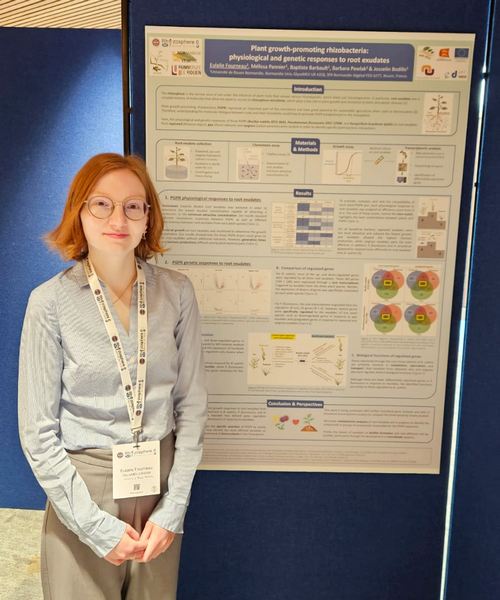Rhizosphere 6 : rooting for earth

La 6ème Conférence Rhizosphere : Rooting for earth s'est déroulée du 15 au 19 juin 2025 à Édimbourg (Écosse), et a accueilli la communauté mondiale de recherche sur la rhizosphère pour présenter les dernières avancées dans la compréhension du monde souterrain des racines des plantes et de leurs interactions avec l'environnement physique, chimique et biologique du sol dans un contexte climatique en mutation.
Le programme des échanges était centré sur les trois défis mondiaux les plus importants auxquels la société est confrontée aujourd'hui, le changement climatique, la perte de biodiversité, la durabilité agricole et environnementale, et sur le rôle fondamental de la recherche sur la rhizosphère pour aider à les résoudre.
Deux membres du Laboratoire GlycoMEV, Dr Eulalie FOURNEAU, post-doctorante, et Vincent LEMAÎTRE, doctorant, ont participé à ces rencontres et ont présenté leurs travaux avec des posters :


Eulalie Fourneau :
« Plant growth-promoting rhizobacteria : physiological and genetic responses to root exudates. »
Eulalie Fourneau, Mélissa Pannier, Baptiste Barbault, Josselin Bodilis, Barbara Pawlak
Résumé :
The rhizosphere is the narrow zone of soil surrounding plant roots that is directly influenced by root exudates. This complex molecular mixture released by roots allows the plant to recruit its rhizosphere microbiota, which plays a key role in its growth and resistance to biotic and abiotic stresses. In the context of sustainable agriculture, understanding the molecular dialogue between roots and their microbiota could help to promote the establishment of beneficial microorganisms in the rhizosphere, such as plant growth-promoting rhizobacteria (PGPR).
In this work, the ability of root exudates from rapeseed (Brassica napus), pea (Pisum sativum) and ryegrass (Lolium perenne) to attract and feed three PGPR strains (Bacillus subtilis ATCC 6633, Pseudomonas fluorescens ATCC 17400 and Azospirillum brasilense Sp245) was measured and compared by defining a new indicator, the “love match” score (Fourneau et al., 2024*). For all bacteria, rapeseed exudates were the most attractive and induced the fastest growth, pea exudates allowed the highest biomass production, while ryegrass exudates were the least effective. When comparing PGPR, P. fluorescens and A. brasilense seemed to respond more efficiently to root exudates than B. subtilis.
In addition, transcriptomic analysis was used to study PGPR gene expression during growth on root exudates. The results showed that B. subtilis regulated the expression of many genes involved in metabolism, transport and sporulation in response to root exudates, whereas P. fluorescens appeared to already express most of the genes required for this response. Each of the three plant species also regulated the expression of specific bacterial genes.
Taken together, our results highlight the specific selection of PGPR by the plant through its root exudates, and could help to select the most efficient exudates in order to promote the establishment of bioinoculants in the rhizosphere.
*doi: 10.3389/fmicb.2024.1473099
Vincent Lemaître :
« Plant cell-wall modification in Pisum sativum and Vicia faba root tissues following early infection by Aphanomyces euteiches. »
Vincent Lemaître, Thomas Badou, Mariane Chedid, Mélanie Fortier, Olivier Perruchon, Marie-Christine Kiefer-Meyer, Maïté Vicré, Marie-Laure Follet
Résumé :
Pea (Pisum sativum) is a legume of agricultural importance due to its high-protein seed content and ability to fix atmospheric nitrogen by symbiotic interaction with Rhizobium bacteria. However, since the 1990s pea crops have been in decline, due to the spreading of the Aphanomyces euteiches pathogen, an oomycete responsible for root rot disease to which pea is highly sensitive. Other legumes such as faba bean (Vicia faba) are less susceptible.
The first stages of Aphanomyces euteiches infection are characterized by the zoospore encystment, and germination on the root surface in the elongation zone. Then, a mycelium develops in this root area during the first hours following infection resulting in a close contact between the oomycete and the plant cell wall in the root elongation zone. While several studies suggest the involvement of plant cell wall glycopolymers such as hydroxyproline-rich glycoproteins (HRGPs), including arabinogalactan proteins (AGPs) and extensins, in root defence, the cell wall remodelling following A. euteiches infection has never been described.
Here, a comparative study was carried out on three legume hosts of A. euteiches two pea genotypes respectively highly and less susceptible and to the oomycete and one faba bean genotype. First, infection is characterized in the three legumes by measuring the surface area of mycelium present on roots and quantifying oomycete genomic DNA. Secondly, the cell wall glycopolymers organization is explored in the root elongation zone using immunocytochemical and biochemical approaches. Finally, AGPs and extensins glycosylation gene expression is explored by qPCR. This work reveals that cell wall glycopolymers are significantly remodeling in pea. The main changes concern the AGPs glycan moiety, enhancing their specific involvement in early steps of A. euteiches infection in pea.
Participation de Eulalie Fourneau
et Vincent Lemaître![]()




 Adresse : 1er étage Bâtiment CURIB, Place E. Blondel, UFR Sciences et Techniques - Université de Rouen Normandie, F-76821 Mont Saint-Aignan CEDEX France
Adresse : 1er étage Bâtiment CURIB, Place E. Blondel, UFR Sciences et Techniques - Université de Rouen Normandie, F-76821 Mont Saint-Aignan CEDEX France Téléphone Secrétaire administrative : +33 (0)2 35 14 63 56
Téléphone Secrétaire administrative : +33 (0)2 35 14 63 56 E-mail Secrétaire administrative :
E-mail Secrétaire administrative : 

